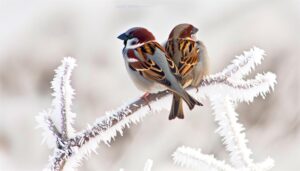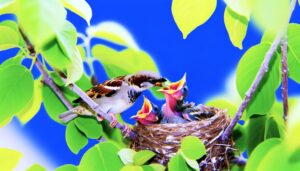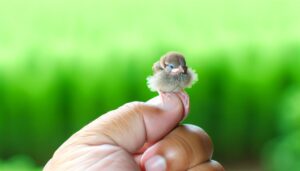How Do Baby Sparrows Often Die and Improve Survival Rates
Yes, baby sparrows often face high mortality rates due to various factors. Predators like domestic cats and snakes account for up to 79% of nest failures.
Extreme weather can dislodge nests or flood them, causing injury or drowning. Human activities such as urbanization and pollution disrupt their habitats and contaminate food sources.
Diseases like avian pox and parasites worsen their chances by impairing health. Food scarcity and poor foraging skills result in malnutrition and starvation.
Effective parental care, including frequent feeding and nest protection, is essential for their survival. If you continue exploring, you'll uncover more about these fascinating dynamics.
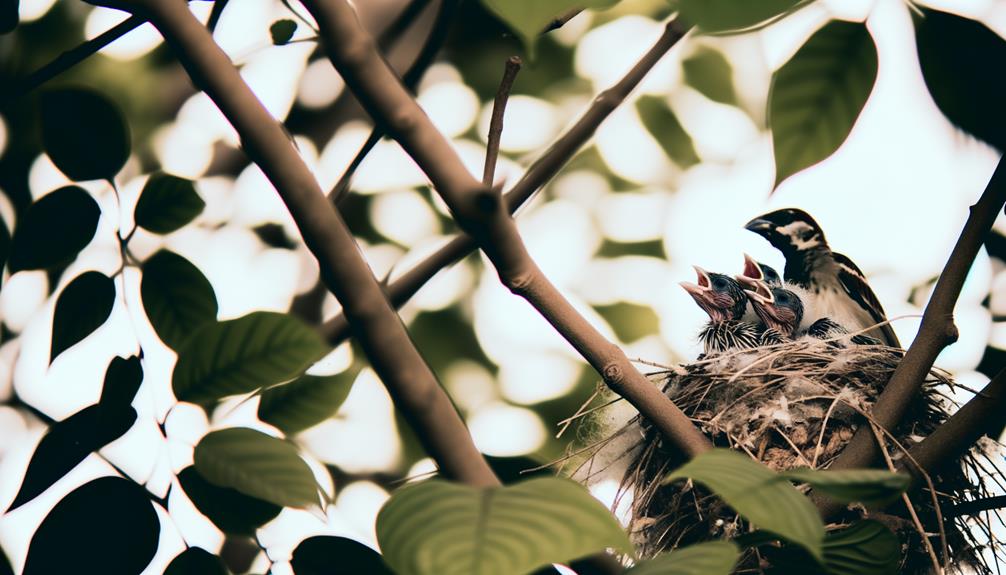
Key Takeaways
- Predation is a leading cause, accounting for up to 79% of nest failures.
- Extreme weather conditions like heavy rainfall and strong winds can lead to nest failure and chick mortality.
- Human activities such as urbanization and pollution contribute to habitat loss and food scarcity.
- Diseases and parasites, including avian pox and salmonellosis, significantly weaken baby sparrows.
- Food scarcity and competition among siblings often result in malnutrition and starvation.
Common Causes of Mortality

Several factors contribute to the high mortality rate of baby sparrows, with predation being one of the most significant causes.
You'll find that environmental stressors also play a pivotal role. Adverse weather conditions, such as heavy rains and extreme temperatures, can lead to hypothermia or dehydration.
Nest parasitism by species like the common cuckoo adds another layer of risk, as these parasitic birds lay their eggs in sparrow nests, often outcompeting the sparrow chicks for resources.
Additionally, food scarcity can severely impact survival rates. When parents struggle to find enough insects and seeds, the nestlings may suffer from malnutrition.
These challenges highlight the delicate balance required to guarantee the survival of these vulnerable young birds.
Impact of Predators
Predators, such as domestic cats, snakes, and birds of prey, exert a notable pressure on baby sparrows, profoundly influencing their mortality rates.
You'll find these predators are adept at locating nests, leading to high predation rates.
Studies indicate that predation accounts for up to 79% of nest failures.
Domestic cats, for instance, are responsible for millions of bird deaths annually.
Snakes, with their ability to climb, pose a threat to even well-hidden nests.
Birds of prey, including hawks and owls, skillfully hunt fledglings and nestlings.
Each predator's presence greatly impacts sparrow populations, disrupting the delicate balance of ecosystems.
Weather-Related Threats
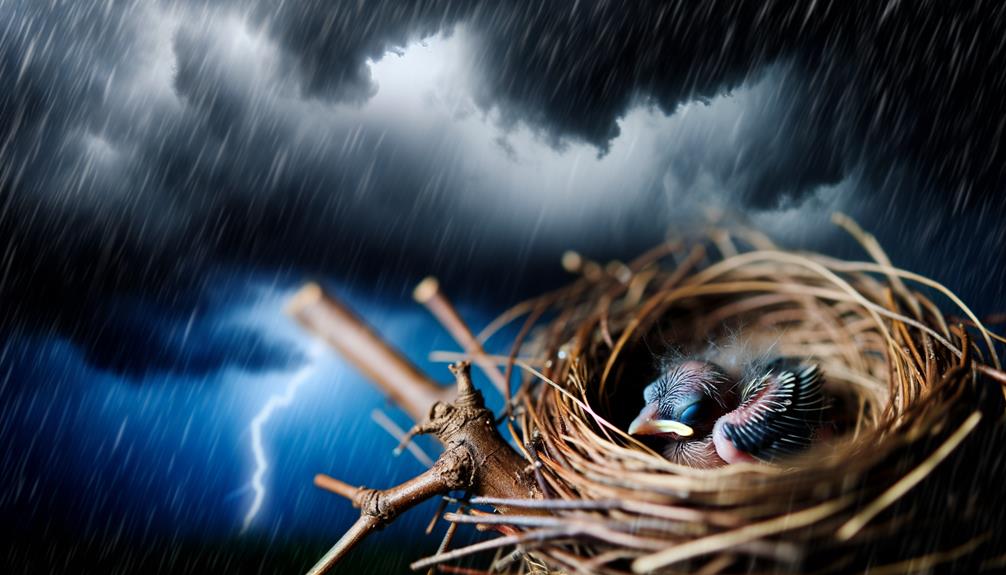
Weather-related threats greatly affect baby sparrow mortality rates, with extreme temperatures, heavy rainfall, and strong winds posing substantial risks to their survival. You'll find that when temperatures swing too high or too low, baby sparrows struggle to regulate their body heat, leading to hypothermia or hyperthermia. Heavy rainfall can flood nests, drowning the chicks, while strong winds can dislodge nests from trees.
Consider this table:
| Weather Condition | Impact on Baby Sparrows | Scientific Terms |
|---|---|---|
| Extreme Temperatures | Heat stress, hypothermia | Thermoregulation issue |
| Heavy Rainfall | Nest flooding, drowning | Hydrological threat |
| Strong Winds | Nest displacement, injury | Aerodynamic instability |
It's clear that mitigating these risks requires understanding and proactive measures to guarantee the survival of these vulnerable birds.
Human Interference
Human interference greatly impacts baby sparrow mortality rates. Urbanization, pollution, and habitat destruction disrupt their natural environments and limit their chances of survival. When cities expand, sparrows lose essential nesting sites, resulting in increased vulnerability to predators and reduced reproductive success.
Pollution, particularly in the form of pesticides and heavy metals, contaminates food sources. This leads to poisoning and stunted growth in nestlings. Habitat destruction due to deforestation and land development reduces the availability of food and shelter, forcing sparrows into suboptimal environments.
You can make a difference by supporting conservation efforts, reducing pesticide use, and preserving green spaces. Every action counts toward creating a safer habitat for baby sparrows, ensuring their survival and the continuation of their species.
Disease and Parasites
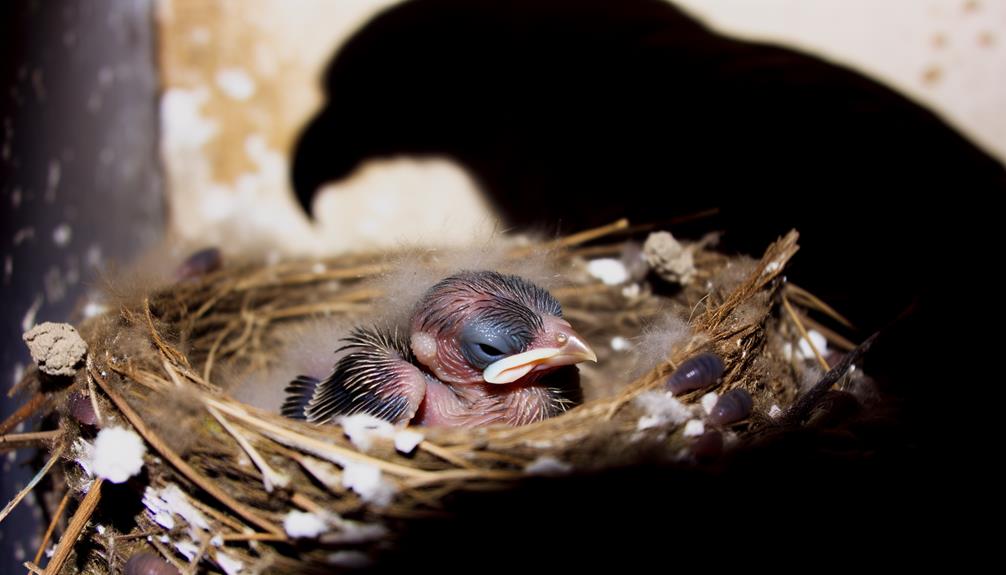
In addition to the threats posed by human interference, baby sparrows face significant mortality risks from diseases and parasites, which can spread rapidly in densely populated areas. Viral infections like avian pox and bacterial diseases such as salmonellosis are common culprits. Parasites, including mites and lice, weaken the chicks by feeding on their blood and causing anemia.
| Disease/Parasite | Impact on Baby Sparrows |
|---|---|
| Avian Pox | Causes lesions, impairs feeding |
| Salmonellosis | Leads to diarrhea, dehydration |
| Mites | Blood loss, anemia |
| Lice | Feather damage, stress |
Observations indicate that these health threats can decimate sparrow populations swiftly. Effective community engagement in monitoring and controlling these issues can make a significant difference in reducing mortality rates among baby sparrows.
Nutrition and Feeding Challenges
Facing formidable challenges, baby sparrows often struggle to obtain adequate nutrition due to competition for food resources and the limited foraging skills of their parents. You might notice that parent sparrows sometimes can't gather enough insects, seeds, and grains to meet the high nutritional demands of their rapidly growing chicks.
This food scarcity results in weaker nestlings, susceptible to starvation and malnutrition. During periods of low food availability, dominant siblings frequently monopolize the limited supply, exacerbating survival disparities. Research indicates that nestling survival rates improve significantly when supplemental feeding is provided.
Importance of Nest Location
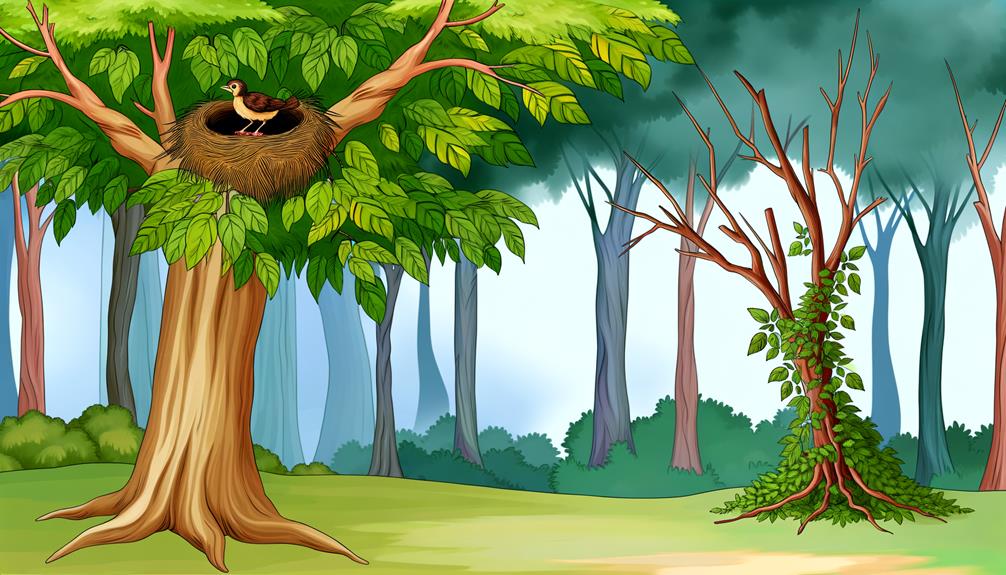
You need to think about the nest's location because it directly impacts the mortality rate of baby sparrows. Proximity to predators, exposure to harsh weather conditions, and frequent human disturbances can greatly increase the risks.
Studies show that well-hidden nests and those positioned in sheltered areas demonstrate higher survival rates.
Predator Threats Nearby
Strategically choosing a nest location can greatly reduce predator threats and boost the survival rate of baby sparrows. When selecting a site, consider factors that minimize exposure to common predators. Evidence shows that nests placed in dense foliage or high up in trees offer better protection.
Consider these key points:
- Elevation: Higher nests are harder for ground predators like cats and raccoons to reach.
- Camouflage: Nesting in areas with abundant natural cover helps conceal nests from aerial predators such as hawks.
- Proximity to Humans: Surprisingly, some predators avoid human activity. Nesting near inhabited buildings can provide a safer environment.
Weather Conditions Impact
Choosing the right nest location is crucial for baby sparrows to withstand extreme weather conditions. Exposure to harsh elements greatly impacts their mortality rate. You need to make sure nests are sheltered from direct sunlight and strong winds to regulate temperature and prevent overheating or hypothermia.
Observations show that nests built in dense foliage or under eaves provide better protection. Studies indicate that exposure to heavy rainfall can lead to nest flooding, causing chicks to drown or suffer from hypothermia. Additionally, placing nests at higher elevations minimizes the risk of ground predators while offering safety from rising water levels during storms.
Human Disturbance Effects
While weather conditions pose significant threats, human disturbance equally impacts the survival rate of baby sparrows by altering nest location dynamics and increasing stress levels.
When you encroach on their habitats, sparrows often relocate their nests, which can lead to several issues:
- Exposure to Predators: New nest sites may lack the natural camouflage and protection, making baby sparrows more vulnerable to predators.
- Reduced Parental Care: Frequent disturbances can cause parents to abandon their nests, leaving chicks without essential care and feeding.
- Thermoregulation Issues: Relocated nests mightn't provide adequate insulation, affecting the chicks' ability to maintain body temperature, essential for their development.
Understanding these impacts helps you better protect sparrow habitats, ensuring higher survival rates for the baby sparrows.
Role of Parental Care
You'll notice that parental care greatly influences baby sparrows' survival rates through various mechanisms.
Frequent feeding guarantees adequate nutrition, while nest protection strategies and vigilant behaviors reduce predation risks.
Studies show that sparrows with attentive parents have higher fledging success compared to those with less involved caregivers.
Feeding Frequency Impact
Observing the feeding frequency of baby sparrows reveals significant insights into the important role of parental care in reducing their mortality rate. You'll notice that attentive parents feed their chicks approximately every 15 minutes. This high feeding frequency is essential for several reasons:
- Nutrient Supply: Frequent feeding guarantees a steady supply of essential nutrients, promoting growth and immune function.
- Energy Maintenance: Regular intake helps maintain high energy levels necessary for thermoregulation and development.
- Reduced Starvation Risk: Consistent feeding minimizes the risk of starvation, which is a leading cause of mortality in baby sparrows.
You can see that attentive parental care, particularly in feeding frequency, is crucial for the survival and healthy development of baby sparrows. This evidence-based understanding underscores the importance of supporting wildlife conservation efforts.
Nest Protection Strategies
Effective nest protection strategies are crucial for the survival of sparrow chicks. Parent sparrows select nesting sites with dense foliage or structures to hide from predators. They reinforce the nest with twigs and leaves for stability against weather extremes. Frequent parental visits provide warmth and deter threats, leading to lower predation rates in active nests. Sparrows also use distraction displays to lure predators away from the nest, creating a safer environment for their chicks.
Scientific studies highlight the benefits of these strategies, showing that they greatly reduce the likelihood of predation and environmental hazards. These efforts collectively improve the survival rates of sparrow chicks, emphasizing the importance of effective nest protection measures.
Parental Vigilance Necessity
Parental vigilance is essential, as continuous monitoring and care from the parent sparrows greatly enhance the chicks' chances of survival by mitigating risks from predators and environmental factors. When you observe sparrow behavior, you'll notice they exhibit several protective strategies.
Constant Feeding: Parent sparrows frequently feed their chicks, providing necessary nutrients and energy for growth and development.
Nest Defense: They actively defend the nest from predators like snakes, cats, and larger birds, using alarm calls and physical deterrence.
Thermoregulation: Parents maintain the nest's temperature, ensuring chicks don't succumb to hypothermia or overheating.
How to Help Baby Sparrows
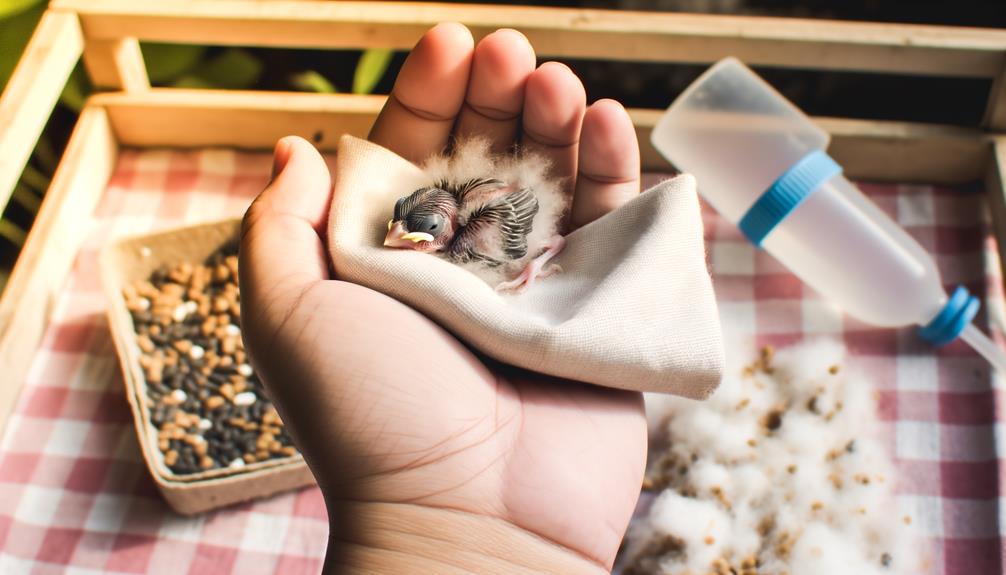
To assist baby sparrows flourish, it's vital to provide a safe environment that mimics their natural habitat and meets their nutritional needs.
Start by creating a sheltered space with materials like grass and feathers to simulate a nest. Place the nest in a quiet, predator-free area.
For nutrition, offer a diet rich in proteins and fats, such as mealworms and mashed hard-boiled eggs. Hydration is crucial; provide fresh water using a shallow dish to prevent drowning.
Monitor their health for signs of malnutrition or illness, consulting avian veterinarians when necessary.
Conclusion
In the intricate dance of nature, baby sparrows face a gauntlet of challenges that can often lead to their untimely demise. Predators, harsh weather, human impact, diseases, and feeding difficulties all play a role.
Just like a fragile ship steering through stormy seas, their survival depends on various factors, including nest location and parental care. By understanding these threats and intervening wisely, you can help improve their chances, ensuring these tiny aviators take flight into a safer world.


